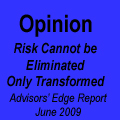BMO has announced:
that BMO Capital Trust II (the “Trust”), a closed-end trust wholly-owned by the Bank, will issue $450 million of BMO Tier 1 Notes – Series A due December 31, 2107 (the “Notes”). The Notes are expected to qualify as Tier 1 capital of the Bank for regulatory purposes. The Trust intends to file a final prospectus with the Canadian securities regulators today, and anticipates that a receipt for the prospectus will be issued on Monday, December 15, 2008.
Interest on the Notes is payable semi-annually. From the date of issue to but excluding December 31, 2018, the rate of interest on the Notes will be fixed at 10.221% per annum. Starting on December 31, 2018, and on every fifth anniversary after such date, the rate of interest on the Notes will be reset as described in the prospectus filed by the Trust and the Bank.
On or after December 31, 2013, the Trust may, at its option and subject to certain conditions, redeem the Notes, in whole or in part.
In certain circumstances, the Notes or interest thereon may be automatically exchanged or paid by the issuance of Class B non-cumulative preferred shares of the Bank.
The transaction is expected to close on December 18, 2008 and the net proceeds will be used by the Bank for general corporate purposes.
This is the first issue I know of that takes advantage of OSFI’s recent reckless rule change to allow Tier 1 Capital with a stated maturity and cumulative income payments.
Existence of these notes will not directly affect the critical Equity/RWA ratio that was most recent review of BMO’s capital on PrefBlog. They do, however, represent a method of bumping up the Tier 1 Capital ratio with issues effectively senior to the preferreds, which certainly shouldn’t give preferred shareholders any cause for celebration.
Update, 2008-12-15: Preferred shareholders can, however, take heart from a $1-billion equity issue:
Bank of Montreal (TSX, NYSE: BMO) today announced an offering of 33,340,000 common shares at CDN$30.00 per share for total gross proceeds of approximately CDN$1.0 billion. The offering will be underwritten on a bought deal basis by a syndicate of underwriters. The Bank has granted to the underwriters an over-allotment option to purchase, on the same terms, up to a further 3,334,000 common shares. The option is exercisable, in whole or in part, up to 30 days after closing. The maximum gross proceeds raised under the offering will be approximately CDN$1.1 billion if the option is exercised in full.
The anticipated closing date of the offering is December 24, 2008. The net proceeds from the offering will be used by the Bank for general corporate purposes. The issue will qualify as Tier 1 capital.
The Bank’s Tier 1 capital ratio was 9.77% as of October 31, 2008. On a pro-forma basis, adjusting for the issuance of CDN$1.0 billion of common equity, the issuance of the CDN$150MM Series 18 Preferred Shares, the issuance of the CDN$450MM BMO Tier 1 Notes – Series A, the redemption of the CDN$250MM Series 6 Preferred Shares and the November 1, 2008 implementation of a new Basel II requirement, the Tier 1 ratio would be approximately 10.4%.
Update, 2008-12-16: The prospectus is now available on SEDAR – Issuer is BMO Capital Trust II, date is December 12:
Starting on December 31, 2018 and on every fifth anniversary of such date thereafter until December 31, 2103 (each such date, an ‘‘Interest Reset Date’’), the interest rate on the BMO Tier 1 Notes—Series A will be reset at an interest rate per annum equal to the Government of Canada Yield (as defined herein) plus 10.50%.
…
Government of Canada Yield means, on any Interest Reset Date, the average of the annual yields as at 12:00 p.m. (Eastern time) on the third Business Day prior to the applicable Interest Reset Date as determined by two Canadian registered investment dealers, each of which will be selected by, and must be independent of, the Bank and the Trust, as being the annual yield to maturity on such date which a non-callable Government of Canada bond would carry, assuming semi-annual compounding, if issued in Canadian dollars in Canada at 100% of its principal amount on such date with a term to maturity of five years.
…
On or after December 31, 2013, the Trust may, at its option, with the prior approval of the Superintendent, on giving not more than 60 nor less than 30 days’ notice to the holders of the BMO Tier 1 Notes — Series A, redeem the BMO Tier 1 Notes — Series A, in whole or in part. The redemption price per $1,000 principal amount of BMO Tier 1 Notes — Series A redeemed on any day that is not an Interest Reset Date will be equal to the greater of par and the Canada Yield Price, and the redemption price per $1,000 principal amount of BMO Tier 1 Notes — Series A redeemed on any Interest Reset Date will be par, together in either case with accrued and unpaid interest to but excluding the date fixed for redemption, subject to any applicable withholding taxes.
…
The Class B Preferred Shares Series 20 will pay fixed quarterly Shares Series 20: non-cumulative preferential cash dividends, as and when declared by the Board of Directors, subject to the provisions of the Bank Act, at the applicable Perpetual Preferred Share Rate on each quarterly dividend payment date, subject to any applicable withholding taxes.
…
Perpetual Preferred Share Rate means the rate per annum equal to the Thirty Year Canada Yield prevailing: (i) in the case of the Class B Preferred Shares Series 20, at the time of the Automatic Exchange; or (ii) in the case of the Class B Deferral Preferred Shares, on the date of issuance of each series of Class B Deferral Preferred Shares, plus, in each case, 3.49%.









































































































